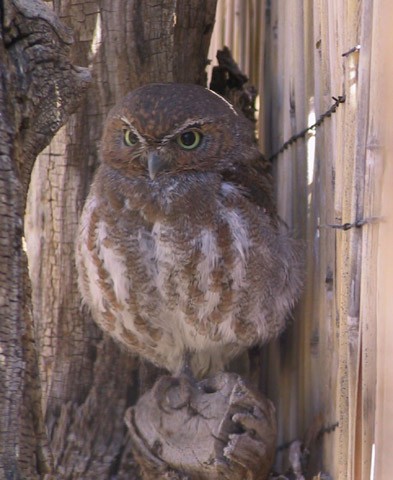Elf Owl
A species of Elf Owls Scientific name : Micrathene whitneyi Genus : Elf Owls
Elf Owl, A species of Elf Owls
Botanical name: Micrathene whitneyi
Genus: Elf Owls
Content
Description General Info
Description
The elf owl (Micrathene whitneyi) is a small grayish brown bird about the size of a sparrow found in the Southwestern United States, central Mexico, and the Baja California peninsula. It has pale yellow eyes highlighted by thin white "eyebrows" and a gray bill with a horn-colored tip. The elf owl frequently inhabits woodpecker holes in saguaro cacti; it also nests in natural tree cavities. It is nocturnal and feeds primarily on insects. 
Size
13-15 cm (5-6 in)
Colors
Brown
Gray
White
Life Expectancy
3-10 years
Nest Placement
Cavity
Clutch Size
1 - 5 eggs
Incubation Period
1 brood
Number of Broods
24 days
Nestling Period
28 - 33 days
Feeding Habits
Elf Owl primarily consumes insects and arthropods, including moths, crickets, scorpions, beetles, and centipedes. They forage acrobatically, capturing prey mid-flight, off plants, or on the ground, even disposing of parts like wings or stingers. They occasionally hunt small mammals, reptiles, birds, and use urban lights to locate insects.
Habitat
Elf Owl inhabit varied environments, from desert areas with saguaro to riparian forests with abundant tree cavities for nesting. Their preferred habitats are marked by a confluence of vegetation such as mesquites, acacias, willows, cottonwoods, and oaks, up to elevations of 5,400 feet. These regions typically encompass arid terrains and higher-elevation pine-oak-juniper zones, extending into urban territories where nest boxes in tree-lined areas are utilized.
Nest Behavior
Breeding pairs of elf Owl do not build their own nests but occupy abandoned cavities where egg-laying and incubation occur, followed by shared parental care for the fledglings.
Nest Characteristics
Elf Owl typically nests in pre-existing cavities, such as old woodpecker holes in trees or saguaro cacti, occasionally utilizing nest boxes.
Dite type
Insectivorous
General Info
Feeding Habits
Bird food type
Bird Feeder Type

Platform
Behavior
Elf Owls reside covertly within tree hollows by day and become nocturnal hunters after dusk. They establish and vigorously defend territories, including several potential nesting sites, against other avian species. Pairs of elf Owl emit characteristic yapping calls to delineate their domains. Their compact foraging range is notable, spanning just 0.5 to 6.4 acres. With social monogamy as a norm, elf Owl exhibit cooperative behaviors, such as communal mobbing of predators and nocturnal migrations in cohesive units, likely comprising kin. Nest failure may prompt a swift relocation to a secondary cavity, showcasing their adaptability within their habitat.
Species Status
Not globally threatened.
